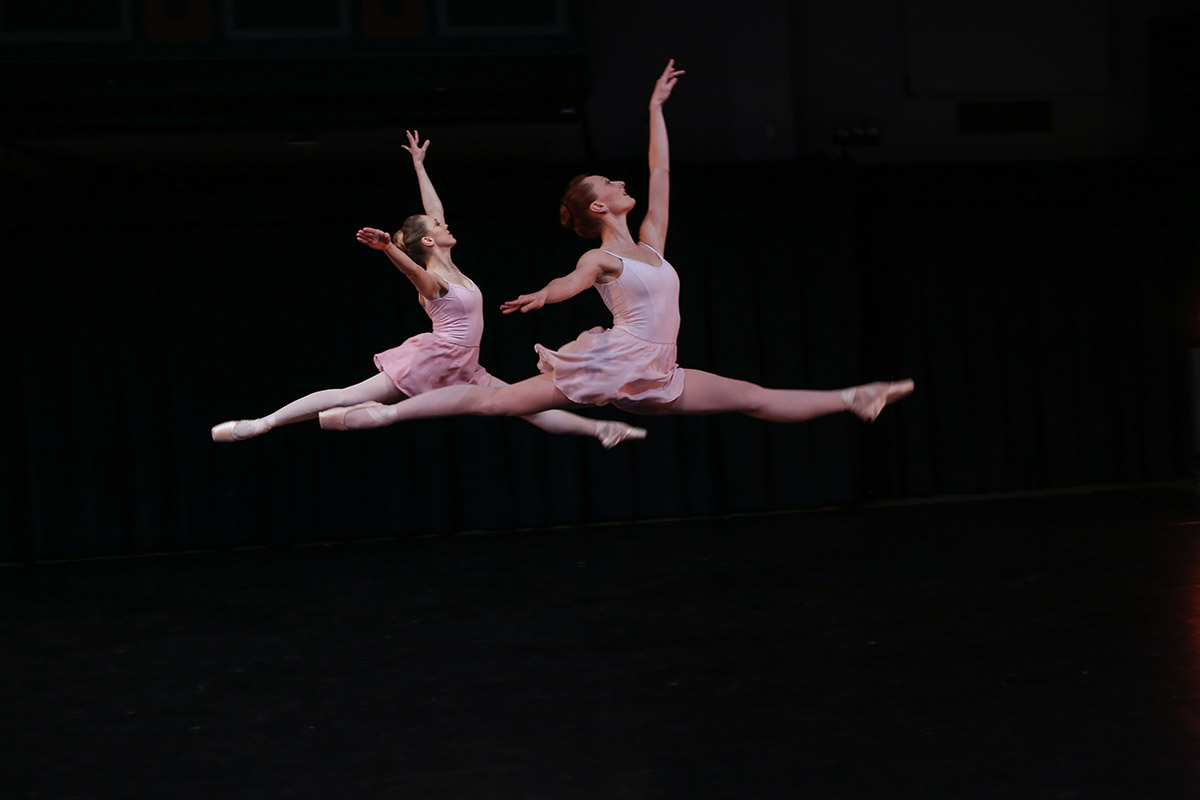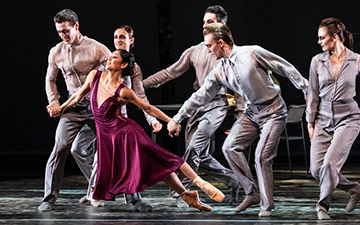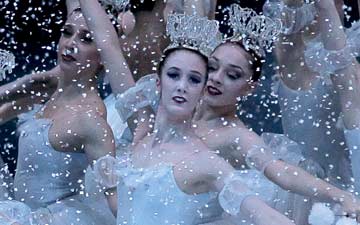
© Julie Lemberger. (Click image for larger version)
New York Theatre Ballet
Septet, Rondo, Concertino, Wings/A Petroushka Collage
★★★✰✰
New York, 92nd Street Y
16 March 2018
nytb.org
www.92y.org
New York Theatre Ballet’s director, Diana Byer, is known for dusting off the dance history books, and giving a dose of challenging revivals. This time NYTB joins may companies around the country and indeed, the world, in celebrating Jerome Robbins’ centennial and locally NYCB will really pull out all the stops with their May programming.
Many were excited by the prospect of seeing three not often performed works: Septet, Rondo, and Concertino. That said, the 92nd St. Y is not exactly the best venue for seeing dance – the small theatre is more like a rehearsal space with some lighting, and seats on risers. Without sitting in the first row, visibility of footwork is virtually nonexistent. Unless someone is lifted or mid-jump, seeing much below the knees was a bit of a wash.
Originally part of 1982’s Four Chamber Works, Septet and Concertino are set to Stravinsky, and once upon a time the entire work was performed with a circus theme. That idea is lost in the bare bones setup at the Y, but in retrospect that now lost context makes some of the choreography (particularly in Concertino), with its wild lifts and vague athletic pomp, make more sense.

© Julie Lemberger. (Click image for larger version)
Septet sees five dancers prance around to music played by two pianists (NYTB’s Music Director Michael Scales and Melody Fader). The movement is constant, and the dancers create diagonals and circles, most often with the dancers facing outward rather than inward.
In Septet, and the closing work – William Whitener’s Wings/A Petroushka Collage – Dawn Gierling Milatin is the standout performer, radiating an intuition that seems more ingrained than learned. Not in the regular NYTB roster, Milatin has trained at the Gelsey Kirkland Academy and performed with Kirkland’s company. No matter where she is on stage, or at what angle, she finds the audience with her eyes, without being cute or affronting. Confident without being conceited, she was by far the most nimble female dancer on stage that night, and the most delightful to watch.
The men were all in good shape, particularly Erez Milatin, though his vamp kohl makeup and mop of hair in Septet gave him a distracting Lou Reed-meets-Hugh Grant look. But his leaps and soft landings were remarkable, as was his fitting casting as Petroushka in Whitener’s “collage.” Milatin’s petite frame and expressive face were appropriate to the piece, which was a condensed, crash course in Fokine’s story ballet of the tragicomic clown.

© Julie Lemberger. (Click image for larger version)
Why would Petroushka need to be revisited or reduced? Who knows, but William Whitener once starred in the role in one of the many mid-70s revivals of the piece when he performed with the Joffrey Ballet. Instead of Stravinsky, Whitener uses Joan Tower’s “Petroushskates.” The cast of women get energetic, abbreviated, choppy renditions of folk dance moves, and the entire aesthetic is a bit like watching animated paper dolls perform. There is a 2d flatness to it, and in this sense, as well as the minimized storytelling, Whitener indeed creates a “collage” in dance.
Robbins’ Rondo, set to Mozart’s eponymous work in A minor, is not new to NYTB and was a bit of a disappointment. The piece is pretty, sweet and relatively simple from a choreographic point of view: two female dancers play within the confines of the rondo musical form, and start dancing either the same or relatable choreography a count apart for much of the work. This was not delineated well on Friday night by Amanda Treiber or Elena Zahlmann. Zahlmann looked particularly wooden despite Mozart’s free flowing, soft solo piano, which has a seductive, almost Slavic tone and rhythm in the returning “A” theme. Treiber, whose technique and execution is commendable, tends to dance with a self-satisfied smirk that did not let up for the length of Rondo.

© Julie Lemberger. (Click image for larger version)
What NYTB really achieved with its stripped down Robbins was the presentation of a philosophical quagmire around Robbins himself. All three Robbins works here are from the very early 1980s. All three are plotless abstract ballets. All three look like Robbins wishing he was Balanchine. But in 1983, Robbins also created an exhilarating masterpiece, Glass Pieces, which looks crisp, fresh and uniquely him, and remains a seminal work in the global repertoire. There is more continuity to Glass Pieces and West Side Story Suite than many may realize: the “running man” he did so well, the hunched bodies, an arched back on popped heels, the street savvy athleticism and jazzy angles. What NYTB makes plain about the man is what they didn’t perform. What makes Robbins great is Robbins being Robbins, not Robbins trying to be Balanchine. As versatile as Robbins was, these chosen three seem to show more weaknesses than strength. While he could never escape Balanchine’s influence, the Robbins works which are most performed, the most beloved and memorable, are not his leotard ballets but Robbins the comedian (The Concert), Robbins the romantic (In the Night, Dances at a Gathering), Robbins the storyteller (The Cage, Fancy Free), Robbins the elegant aesthete (Antique Epigraphs), among many others. Robbins’ musicality and rhythmic sensibilities were different from Mr. B’s, as was his desire to capture inexplicable aspects of humanity. All the more reason to get in line for City Ballet’s upcoming Robbins programming.

















You must be logged in to post a comment.